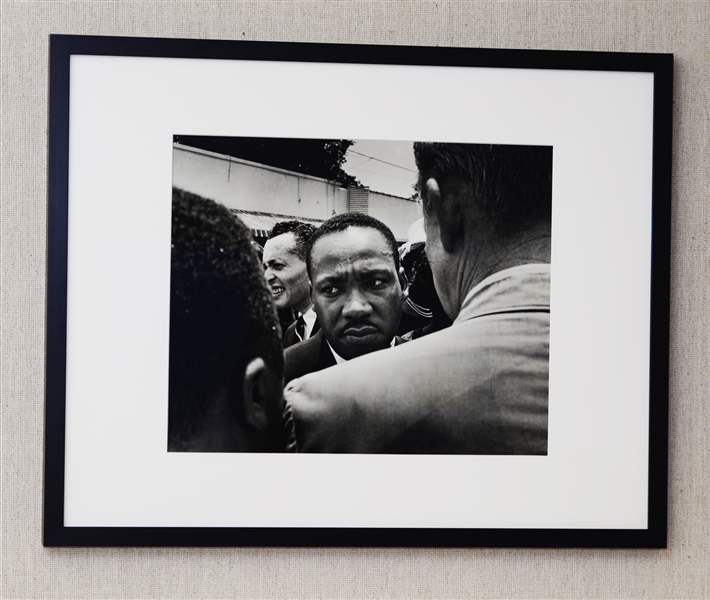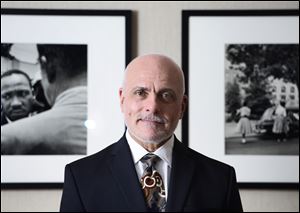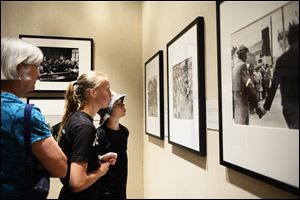
Art museum marks '50 years of Civil Rights'
7/4/2014
"Dr. Martin Luther King is Confronted", photograph by Ernest C. Withers, at the "People Get Ready: 50 Years of Civil Rights" exhibit at the Toledo Museum of Art.
The Blade/Isaac Hale
Buy This Image

Tom Loeffler, curator of the "People Get Ready: 50 Years of Civil Rights" exhibit at the Toledo Museum of Art.
Small wonder the Toledo Museum of Art chose the name of a popular Curtis Mayfield song as part of the title of a new exhibition, People Get Ready: 50 Years of Civil Rights.
Mayfield's 1965 composition conveyed a message when the nation was in the throes of the civil rights upheaval. The lyrics captured the yearnings of a people -- African-Americans or Negroes and coloreds, as they were labeled then – who longed for a better life. And like Negro spirituals and some gospel music, the lyrics held out hope that one day things would change for the better.
Things did improve, and the exhibition, which opened a week ago, acknowledges the difficulties encountered along the way with 35 works of art and photographs selected from the museum's collection by Tom Loeffler, assistant curator of works of art on paper. The exhibition is up through Sept. 21, in the Grace J. Hitchcock Print Gallery and offers an account of blacks' struggle from slavery through to the modern civil rights era.
On this July 4, as the nation celebrates its 238th year of independence, it‘s worth noting that a half century of equal access to public facilities and education was obtained on July 2, 1964, when President Lyndon Johnson signed the Civil Rights Act into law
A museum donor brought to the institution's attention that 2014 marks 50 years since the signing of the law that President Kennedy called for the summer prior to his 1963 assassination.

"Dr. Martin Luther King is Confronted", photograph by Ernest C. Withers, at the "People Get Ready: 50 Years of Civil Rights" exhibit at the Toledo Museum of Art.
Mr. Loeffler said the donor told museum officials that, “we should have something up about [the 50 year mark] and we agreed with her and put the show together.”
“I am limited by the collection at the Toledo Museum of Art and, unfortunately, we don't have a lot of images that relate to the civil rights movement and segregation,” he said. He added that if collectors want to make donations of works that reflect that era, please call the museum. “I put out nearly everything that relates to the movement. We could use much more.”
Photographs, woodblock etchings, prints, and other work by such notables as Aminah Robinson, Elizabeth Catlett, David Levinthal, Ernest C. Withers, and Gordon Parks tell stories about the nation's dark history of slavery, the shame of segregation, the effort to shatter walls of separation, and a glimpse into a more recent and improved time.

From left, Karon Schockman, Sarai Starfeldt, 14, and Caleb Starfeldt, 12, view art at the "People Get Ready: 50 Years of Civil Rights" exhibit.
Photos from Withers' portfolio I Am A Man suggest that he was often in the right place at the right time, as he was often present during noteworthy civil rights events, including the Rev. Martin Luther King, Jr.’s funeral and the first desegregated bus ride in Montgomery, Ala. Also, Catlett's color lithographs To Marry... showing a couple marrying and Playmates showing children playing ball, draws viewers‘ attention to how emotionally and mentally draining life was for black Americans. It helps observers know that black people also take part in life's mundane and special activities as does anyone else.
These works are bound to jar the memories of those who lived through those times. Some will recall seeing images of Reverend King and Malcolm X on black-and-white television screens in consoles that served as pieces of furniture in family living rooms. The exhibition also will educate younger generations and help them to understand that the liberties they enjoy now were not available to their forebearers, but that prejudice and bigotry were far more overt and kept their parents and grandparents in subpar public facilities, restaurants, and schools.

"Homage to George Jackson" by Antonio Frasconi.
The exhibition is small but powerful, clearly showing that change is possible. In the half century since the 1964 civil rights bill became law, doors have opened on numerous levels for African-Americans to fully participate in a democracy that by many standards is still in its infancy.
The story is not complete. Visitors to the exhibition can have their own say about how far they believe the nation has come and what it has yet to accomplish. The museum encourage visitors to write those views as part of the exhibit, perspectives bound to make for compelling reading.
Contact Rose Russell at rrussell@theblade.com or 419-724-6178.